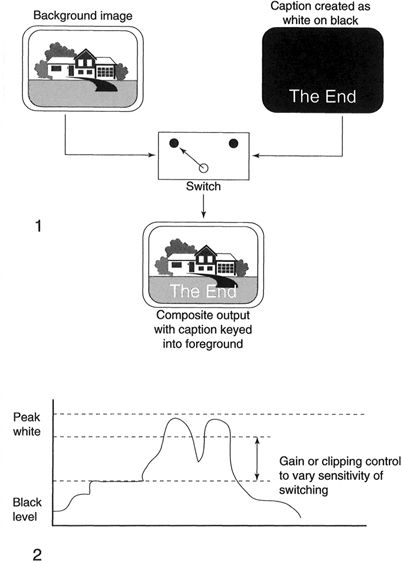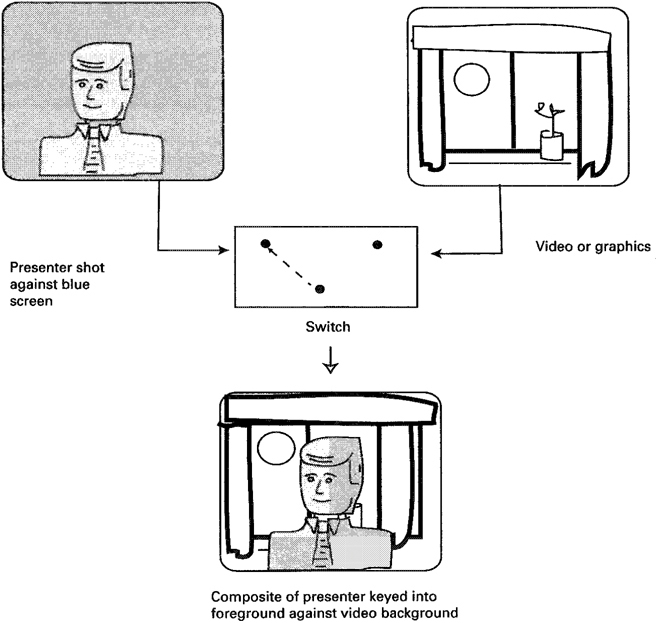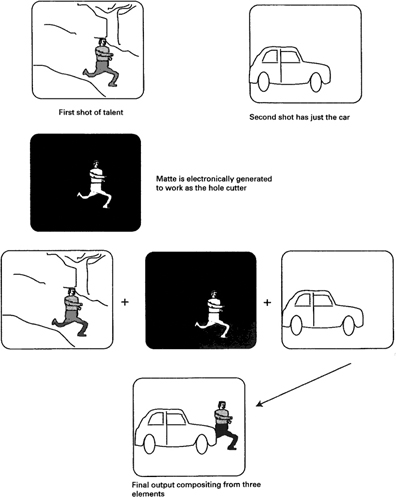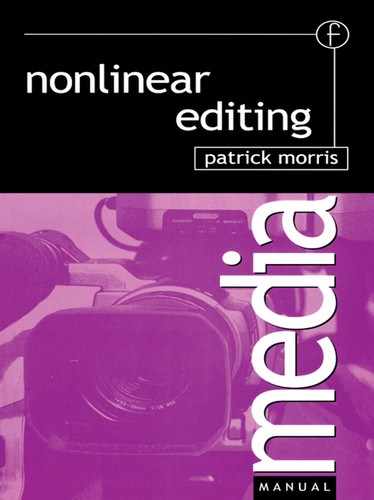Chapter 7
Hole cutters
‘Hole cutters’ is a generic term which may be used to cover a number of techniques that are essentially image-compositing processes. The four techniques are:
• luminance key;
• chrominance key;
• matte key;
• alpha channels.
Luminance key
Luminance key is the process where a ‘hole’ can be cut in a background image based on the brightness of a second image. Historically, luminance keys were white on black captions, the white of the caption being used to cut a hole on the background video and then the white (or a colour from the vision mixer) being used to fill the hole. Luminance key is sometimes known as self key. In its simplest form a switching circuit would cut between the background and the key signal based on the luminance of the keying signal. Alternatively, any part of the image in the foreground that is at colour black will be transparent, the background image being visible wherever the foreground is black.
Many nonlinear systems will allow an image to be luminance inverted, or if necessary the image could be put through a graphics programme to perform an inversion that might be required.
Luminance key

(1) Two sources combined using luminance of foreground image.
(1) Keying controls wil! adjust for degree of keying so that detail in the black does not appear in the foreground.
Chrominance Icey
Chrominance key is sometimes known as CSO (Colour Separation Overlay). This technique relies on colour to create the hole. Typically blue or green is used in television. As with luminance keys, two source video streams are needed: one the background, the second the chroma key foreground. A common instance where chroma key is used is with a television presenter. Here the presenter is shot against a chroma key blue background and keyed over either computer-generated graphics or a video image of a different location. The two, when keyed together, give a composite where the presenter appears to be in front of a background image.
While a presenter will usually be in a studio, it is not uncommon for magazine shows to shoot their presenters against a portable chroma key blue flip-out backdrop. This recorded video can then be chroma keyed over any background – graphics or video of a different location. In its simplest sense it is as if a fast-acting switch switches between the background and the foreground image based on the switching colour of the foreground image.
For any chroma key source, care must be exercised with the lighting of the background. If there are too many shadows from a presenter, difficulty may be experienced when trying to perform the chroma key in the nonlinear system. Depending on the sophistication of the system either colour suppression or colour ranging will be available. Colour ranging allows a range of colour to be selected to help with chroma keying – this is particularly useful when shadows exist on the chroma key background. Colour suppression offers a technique whereby blue colour fringing (typically on hair) can be selected and changed to a grey tone. The fringing is still there but is less objectionable.
As the digitizing process creates images based on blocks or pixels, the quality of any keyed effect will be dependent on the resolution used to capture all the necessary elements. For best results capture the video footage at the highest resolution possible to minimize any unwanted artefacts.
Chrominance key

With good lighting and careful set-up excellent results can be obtained with chroma key. Not all nonlinear systems offer real-time chroma key, while some offer the added sophistication of colour suppression.
Matte key
Matte key is a two-element process: the fill and the hole cutter. Computer animations are one area where matte key may be used. If a production requires computer animation composited with live action video, chroma key and luminance keying techniques frequently are inadequate. This could be because blue, white and black all exist in the computer-generated animation. Matte key can also be applied when a scene to be shot could be dangerous – for example, a chase scene, where a car just misses ‘our hero’. If the shot is such that the actor will be clearly visible then using a stunt man is not an option. So the scene will first be shot with the actor running through the shot, then the scene is shot again with just the car. In post-production a matte key is created that exactly maps an outline of the actor running – usually a white on black. This white on black matte key is then used to cut the hole on the shot with the car and the take with just the actor is then run synchronously with the matte key to provide the overall key.
Matte generation on desktop systems can be very time-consuming. The matte must match all movement exactly if the process is to be successful. This means that the white on black is created on a frame-by-frame basis.
Alpha channels
Alpha channels are usually associated with still images generated within a graphics programme, for example Photoshop. In some ways they are very similar to matte keys, in that an alpha channel will be a white on black (or black on white depending on the software) element within the graphic file format. On the Macintosh platform the most common file format used that supports alpha channels is the PICT file format. On a Wintel platform, the TIFF file format is a common choice. In both cases, to take advantage of alpha channels you must use the 32 bit option when saving a graphic from the graphics programme before importing for use into the editing system.
Matte key

Powerful technique for compositing moving images. While possible on desktop systems, the matte generation is generally created on a frame-by-frame basis and is time consuming.
